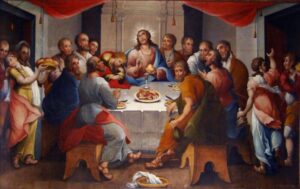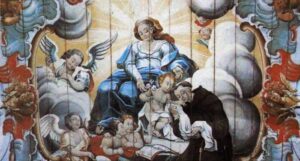Baroque appeared in Brazil a little later, in the 18th century.
The Baroque of Minas Gerais was a peculiar version of the Baroque that developed in Minas Gerais between the 18th and 19th centuries.
Architecture, Painting, Sacred Sculpture and Music played an important role in the Minas Gerais Baroque. Evoking religion in every detail, the Baroque of Minas Gerais followed the trend of Baroque art, growing mainly around churches and brotherhoods.
The history of Minas Gerais begins with the first bandeiras from São Paulo who explored the territory in the 16th century, but it was not until the end of the 17th century, with the discovery of gold deposits and other precious stones, that the first towns were built and the territory occupied, as bandeirantes and foreigners were attracted by the riches the place would offer.
At first, the city was attached to the Captaincy of Rio de Janeiro, but as the bandeirantes of São Paulo were said to be the ones who found the gold mines, in 1709 Minas joined the Captaincy of São Paulo to form the Captaincy of São Paulo and Minas Gerais. It was not until 1720 that it became autonomous and was called the Captaincy of Minas Gerais.
In addition to the first explorers, large numbers of royalty and inhabitants from other areas of the colony arrived in the Captaincy, enchanted by the news of the gold there.
From then on, countless Portuguese, including artists, came from the metropolis to the colony in search of rapid enrichment, bringing with them many engravings and illustrated sacred books that would be used as references in colonial painting.
Thus, the first artists were the Portuguese, who passed on their techniques and references to the Brazilians, who reproduced them in their works.
São Paulo didn’t have such a splendid spread of Baroque, which leads us to believe that the influence of the movement in Minas Gerais really came from the metropolis. However, we can’t underestimate the people from São Paulo and other settlers, who certainly brought traces of this art to Minas Gerais, albeit with less representation.
Unlike other schools, such as Bahia and Pernambuco, which were much more linked to the formal style of European art, the Baroque of Minas Gerais was characterised by diversity and eclecticism.
The Baroque of Minas Gerais did not follow academic standards, preferring the use of more uniform colours and more naive and youthful features.
In fact, with the large contingent of people arriving in the “new” lands, towns such as Sabará, Mariana, Ouro Preto, São João Del Rei and Congonhas do Campo began to develop and form their large buildings, which required an architectural influence, in this case the Baroque.
In terms of colonial architecture in Minas Gerais, we can briefly mention Antônio Francisco Lisboa, or Aleijadinho, as the greatest and most famous architect of the Brazilian Baroque.
Because of his unique talent, the religious orders, especially the Carmelites and the Franciscans, commissioned his work, He designed the Church of St Francis in the city of Ouro Preto and the Church of Bom Jesus de Matosinhos in Congonhas do Campo.
The sculptor always used medallions and carvings, many of them gilded, and it was in the Sanctuary of Matosinhos that he created one of his greatest works, the Twelve Prophets, sculpted so that their gestures are coordinated and give the impression of movement.
It’s worth noting that Baroque architecture and painting have always been linked, as many of the iconographic productions developed thanks to the large ceilings and walls of buildings – mainly churches – that needed to be decorated. So painters came in to make the decorations.
Aleijadinho and the painter Manuel da Costa Ataíde worked on the Church of St Francis of Assisi in Ouro Preto.
In the case of Colonial Baroque painting in Minas Gerais, it is important to note that the use of European models was common for painters of the time. However, they cannot be characterised as mere copyists, devoid of creativity and talent.
Imitation would rather be defined as the invention of another work, but without concealing the model, because often the artist’s appreciation of the work was so great that he wanted to equal or surpass the original work.
Perhaps in the Brazilian case the question of why copies are used is somewhat different, although this first hypothesis cannot be ruled out.
For art or literature to reach the Brazilian colony, it first had to pass a judgment in Portugal, which could censor the work and prevent it from reaching the Americas.
In this way, most of what arrived here with Portuguese approval was of a religious nature, such as Missals, Bibles and other sacred books.
Many of these books were accompanied by illustrations of biblical passages and of the most important religious events in the Christian imagination.
Since most of the artists from Minas Gerais were financed by clerics, parishes and brotherhoods, it was up to them to produce Catholic-oriented works, using the engravings they had here, taken from religious books – it was better to copy what had already been approved by Portugal than to try to innovate and end up being censored by the colony’s inspectors.
This is perhaps where the feeling of imitation for the artist on the other side of the Atlantic comes in, as admiration could lead to the desire to do something similar in order to be equally beautiful.
These factors led the same artist to produce homogeneous works, since the prints they were inspired by were by different painters.
Manuel da Costa Ataíde, or Master Ataíde, was one of the artists who used other works to compose his productions.
He was born in Mariana around 1762 and little is known about his life.
The great characteristic of his paintings is that he made very good use of perspective – for example, columns that seem to rise towards the sky in interaction with angels and saints – in the paintings on the ceilings of churches and also in individual works.
The decline of the Baroque did not mean the end of the plastic arts in Minas Gerais; from the second half of the 19th century, painting, already separated from architecture, developed under the influence of European, neoclassicism and romanticism.
The greatest exponents of Minas Gerais Baroque were the masters Ataíde and Aleijadinho.
Biographies of Manuel da Costa Ataíde and Aleijadinho
1. Manuel da Costa Ataíde
Master Ataíde was born in Mariana in 1762 and died in 1830, at the age of 68. He was one of the most important painters, gilders and craftsmen in the art of incarnation.
Little is known of Ataíde’s life. His first public work was the painting of two icons of Jesus for the Church of Senhor Bom Jesus de Matosinhos in Congonhas do Campo in 1781.
He was one of the few recognised painters from Minas Gerais in this period. He was seen as a human figure, religious, a member of various brotherhoods, a materially detached person who charged fair prices for his works.
Video showing the biography of Master Ataíde

2. Aleijadinho’s Biography
Antônio Francisco Lisboa, known as Aleijadinho, was born in Cachoeira do Campo, a district of Ouro Preto, in the first half of the 18th century.
Antônio Francisco Lisboa changed the history of art in Brazil. Master Aleijadinho, as he became known throughout the world, was so named because of the disability that afflicted him until his death.
Much of the artistic production of Master Aleijadinho’s workshop is concentrated in the historic city of Ouro Preto.
But Congonhas is home to the famous Bom Jesus do Matosinhos Sanctuary, with the Twelve Prophets carved in soapstone and the Six Steps of the Passion of Christ.
Among the icons of the artist’s work is the Church of St Francis of Assisi, which he designed in 1766. This work also contains details from his workshop, such as the high altar, the altarpiece, the frontispiece and the fountain-lavabo in the sacristy.
In 1767 his father, the Portuguese architect Manoel Francisco Lisboa, died. However, as Aleijadinho was not a legitimate son, he was not included in the will.
In 1777, Aleijadinho went to the city of Rio de Janeiro for legal proceedings to recognise his son’s paternity, who had the same name as his grandfather, Manoel Francisco Lisboa, with a slave, like his mother when he was born, named Narciza Rodrigues da Conceição.
That same year he was diagnosed with a serious illness that deformed his body and limbs, especially his hands.
The nickname Aleijadinho was given to the artist because of this illness, which caused him to work on his knees after losing his toes. Despite his illness, the master craftsman continued to work in his workshop.
In 1800, the artist worked on the soapstone statues of the Prophets, which are located in the churchy of the Sanctuary of Bom Jesus de Matosinhos in Congonhas. The Six Steps of the Passion of Christ, represented in the chapels in front of the sanctuary, were also made at this time, also by the workshop of Master Aleijadinho.
The Prophets and the Passion of Christ in Congonhas and the Church of Saint Francis of Assisi in Ouro Preto are considered the master’s greatest works.
Aleijadinho also left chapels, churches and ornaments in various cities such as Sabará, São João del-Rei, Tiradentes, Caeté, Mariana, Felixlândia, Matosinhos, Barão de Cocais and São Paulo (capital), with pieces now on display in the Palácio dos Bandeirantes.
See also the complete biography of Aleijadinho.
The Baroque of Minas Gerais
- The influence of geography on Baroque architecture in Minas Gerais
- Characteristics of Baroque sculpture in Minas Gerais
- The Baroque painting of Master Ataíde: Spirituality, technique and symbolism
- Master Ataíde’s main works
1. The Influence of Geography on the Baroque Architecture of Minas Gerais
The mountainous and irregular geographical configuration of the Minas Gerais region played a fundamental role in the development of a unique Baroque architecture.
The rugged terrain, characterised by hills and valleys, directly influenced the process of urban settlement, resulting in a distinctive and visually striking form of urbanisation.
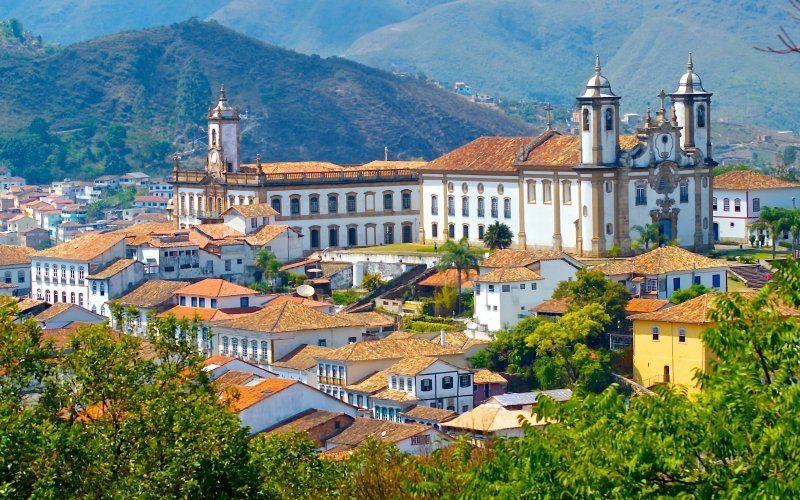
The most important religious temples were built on the highest points of the cities, a strategy that gave these buildings greater visibility and symbolic importance. This arrangement contributed to an aesthetic integration between sacred architecture and the natural landscape, reinforcing the contemplative and spiritual character of the urban space.
Far from being an obstacle, the challenging topography was incorporated into the urban and architectural design, creating a scenery of great visual expressiveness that continues to interest scholars and visitors today. As a result of this process, the historic cities of Minas Gerais became one of the main centres of Brazilian Baroque.
2. Characteristics of Baroque sculpture in Minas Gerais
Baroque sculpture in Minas Gerais developed its own characteristics, partly due to its geographical isolation from the coast, which made it difficult to import European works and materials, especially those of Portuguese origin.
Faced with these limitations, local artists began to use materials available in the region, such as cedar and soapstone, adapting their techniques to the material and structural conditions of the environment. This creative adaptation resulted in an original sculptural production that reflects both the European influence and the local conditions of artistic production.

One of the most emblematic examples of this sculptural expression is the Twelve Prophets of Aleijadinho, located in the churchyard of the Sanctuary of Bom Jesus de Matozinhos, in the city of Congonhas. These sculptures synthesise the technical richness and symbolic complexity of the artist’s work. The ensemble stands out as an example of Brazilian Baroque, due to the scenographic arrangement of the statues in a carefully planned architectural space.
Individually, however, the figures present asymmetries and ornamental details reminiscent of the Rococo style, revealing an aesthetic fusion that marks the originality and expressiveness of the Minas Gerais Baroque.
3. Master Ataíde’s Baroque painting: Spirituality, technique and symbolism
The painting of Mestre Ataíde is known for its deep spirituality and visually disturbing style, characterised by strong symbolic and technical elements. His works are notable for their use of contrast between light and dark, a technique that intensifies the sense of depth and drama. In addition, he often uses figures that are disproportionate to the perspective, challenging the classical canon of visual balance.
His asymmetrical and diagonal composition breaks with the geometric unity and balance of the Renaissance and adopts a grandiose, monumental and twisted aesthetic, typical of the Late Baroque and close to the Rococo.
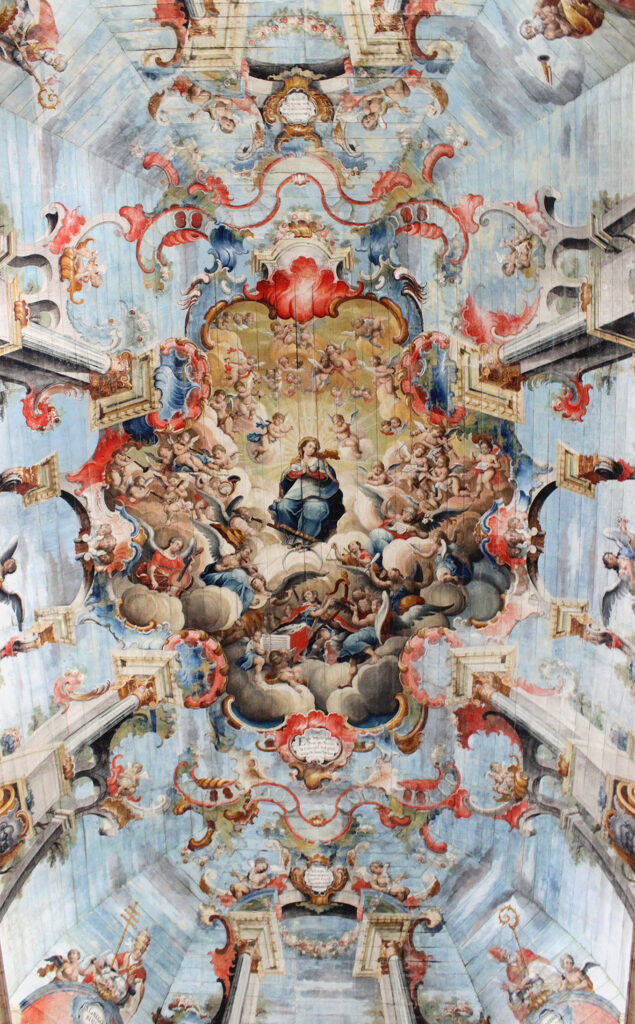
3.1. The symbolism of colour in Baroque painting
In Baroque painting, colours have a function that goes beyond the purely aesthetic: they are fundamental elements of sacred iconography, carrying spiritual and emotional meanings.
Through the use of his palette, Mestre Ataíde “brings colours and images to life”, giving them symbolic vitality. Among the most recurrent colours in his work are red and blue, both of which have a deep symbolic content:
- Red, in the baroque iconographic tradition, represents divine love, charity, worship of God, as well as sacred reverence, spiritual protection, mystical ecstasy, martyrdom, suffering, royalty and absolute power.
Red is also associated with a sense of vital energy and sublimated sexuality, expressed in symbolic interpretations that contrast it with blue:
“Bright, garish red reliably indicates sexual extroversion, albeit sublimated by sacred motifs […] It provides us symbolically with the manifesting elements of unsuppressed sexuality, as does blue, the opposing feelings embedded in the decorator’s soul.”
- Blue in turn refers to obscurity, the supernatural, divine mystery and ecstasy in the face of extraterrestrial life. Its association with the infinite inspires dreams, arouses mystical curiosity and attracts the faithful to faith and contemplation.
3.2. The symbolism of gold
The use of gold in Baroque painting and sculpture is not merely decorative, but deeply symbolic. Yellow, Gold and the Sun are three degrees of the same spiritual revelation, symbolising the union of the soul with God and the divine light manifested to the profane.
Although gold is a precious metal, in Baroque iconographic practice it itself acquires the symbolic value of divine light – pure, genuine and transcendent. In this way, the use of gold in architectural and pictorial elements seeks to materialise the sacred, transforming the artistic space into an expression of the divine presence.
4. Master Ataíde’s main works
- Ceiling Paintings
- Easel Painting
- Wood carving, gilding and statue painting
The ceilings are Master Ataíde’s most remarkable legacy.
4.1. Paintings on the ceilings
4.1.1. The “Ascension of Christ” in the Matriz de Santo Antônio in Santa Bárbara: the beginning of Master Ataíde’s pictorial illusionism
The ceiling of the Matriz de Santo Antônio, located in the city of Santa Bárbara (MG), contains what is probably Mestre Ataíde’s first work in the illusionist genre. This composition marks a decisive moment in the painter’s career, inaugurating a phase in which painting merges with architecture, creating a visual experience of depth and theatricality.
The technique of architectural illusion begins in the cymatium, where the artist painted two consoles on either side of the nave, beginning the visual construction of a fictional three-dimensional space.
On each console, he painted a pedestal and a column, which are connected to the central medallion by a delicate shell, an ornamental element typical of rococo, which enhances the lightness and fluidity of the composition.
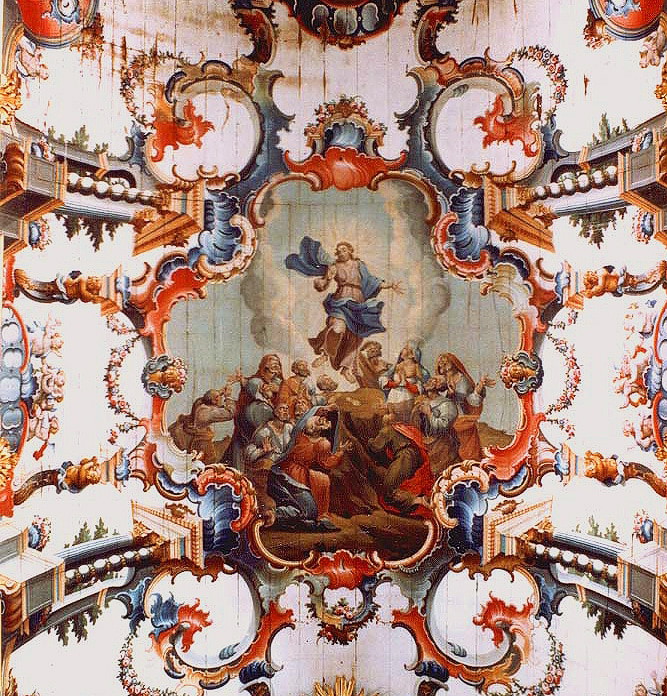
The scene is enriched by various illusionistic elements, such as figures of Atlantis, false pillars, painted pulpits, vegetation and rockeries, forming an ensemble that challenges the boundaries between the real and the represented, between the material structure and the painting.
In the centre of the ceiling, the main medallion depicts the Ascension of Christ, surrounded by the Twelve Apostles and the Virgin Mary. The arrangement of the figures and the treatment of the light give the scene a character of spiritual elevation, directing the viewer’s gaze upwards, in keeping with the devotional purposes of the sacred space.
4.1.2. The Assumption is one of Mestre Ataíde’s most famous and well known works.
The Assumption is one of the most emblematic and recognised works by the painter Mestre Ataíde, both for its compositional complexity and its symbolic expressiveness.
The central medallion depicts the Glorious Assumption of the Virgin Mary, surrounded by a lively celestial orchestra of angels, represented in different ages and attitudes, giving the scene dynamism and variety.
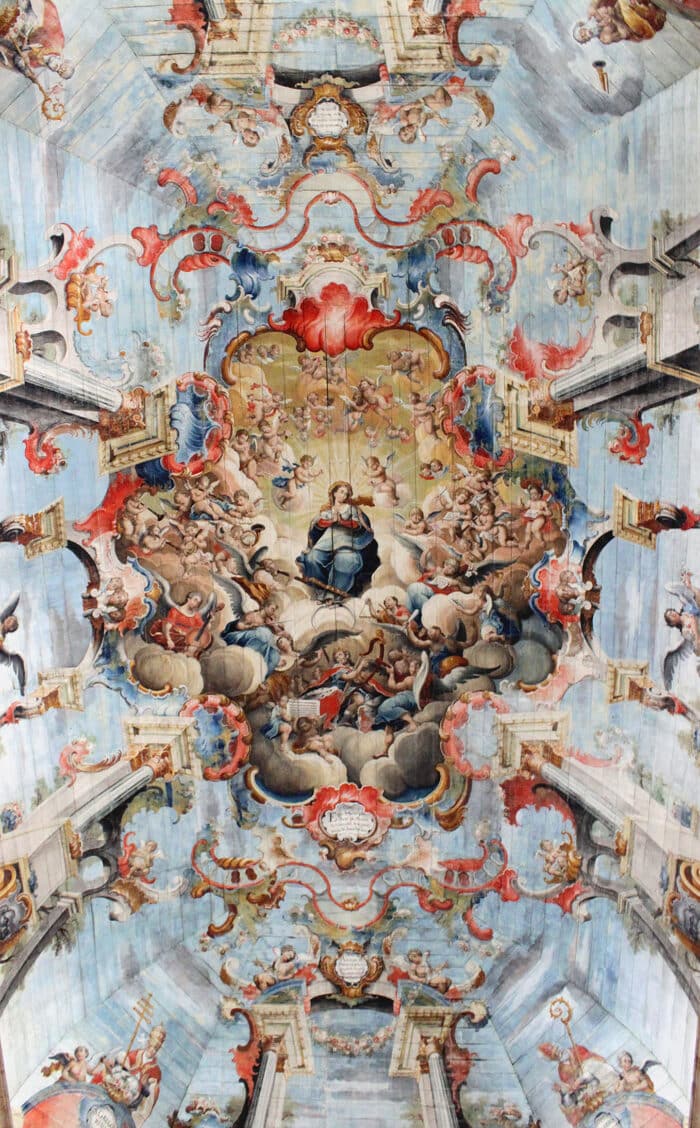
In particular, both Mary and several angels have Afro-descendant features, revealing a unique feature of Ataíde’s artistic production, which introduces elements of local reality into traditional iconography, humanising the sacred figures and proposing an inclusive representation in the Brazilian colonial context.
The Virgin appears in an attitude of prayer, seated on a throne of clouds, surrounded by rays of light and supported by a moon crescent, the traditional symbol of the Immaculate Conception, which reinforces her celestial and pure character.
It is a visually dense composition, characterised by its expressive use of colour, its integration with the architecture of the church and its strong spiritual and devotional content, central characteristics of Baroque painting in Minas Gerais.
4.1.3. Master Ataíde’s Illusionistic Painting
Master Ataíde’s Illusionistic Painting in the Matriz de Santo Antônio in Ouro Branco and the Representations in the Church of São Francisco de Assis in Mariana.
One of the most remarkable illusionist works attributed to Mestre Ataíde is on the ceiling of the Matriz de Santo Antônio in the town of Ouro Branco. In this composition, the use of straight lines predominates, breaking with the Baroque tradition of sinuous curves and scenic movement. Both the organisation of the pictorial space and the colour palette used show innovative choices for the period.
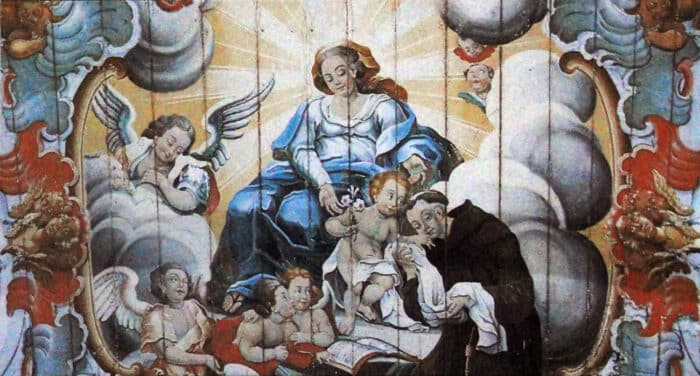
The richly decorated centre medallion depicts the Virgin Mary, the Jesus Child and the St Anthony of Lisbon. Mary is enthroned on clouds, with a serene and welcoming countenance, while the Child Jesus, standing on a table, addresses St Anthony in a devotional attitude, giving the scene an aura of intimacy and sacredness.
In the Church of St Francis of Assisi in Mariana, two important compositions share the ceiling of the Sacristy, both depicting the Agony of St Francis. Although there are no documents formally attesting to Mestre Ataíde’s authorship, the work has been attributed to the artist through comparative studies carried out by various specialists, who have identified characteristic stylistic traits in his production.
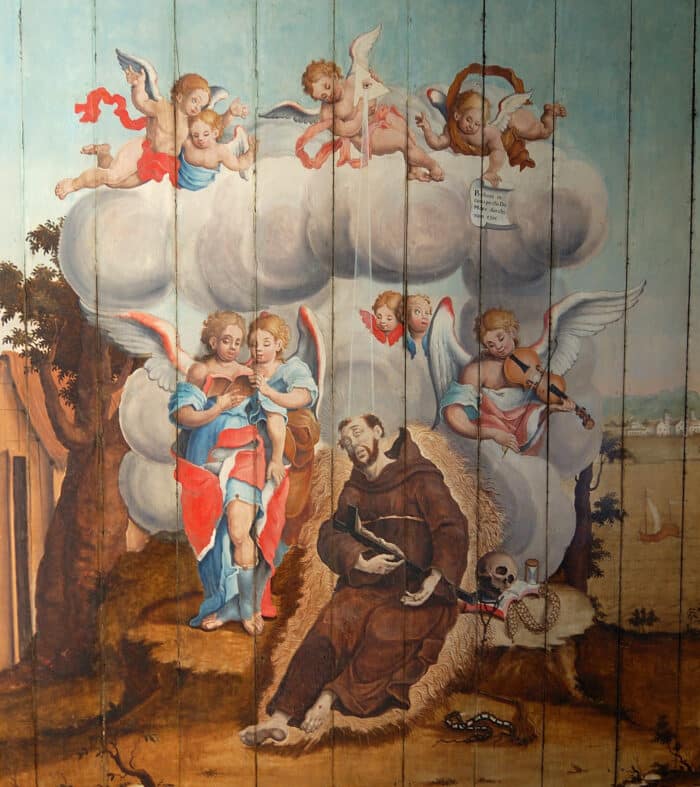
In contrast to the illusionist painting in the Matriz de Santo Antônio, in the Mariana works the artist opted for large open scenes with landscaped backgrounds, in which his ability to convey profound meanings through the manipulation of colours and compositional balance is evident. This is a clear example of Ataíde’s versatility, able to adapt to different narrative and spatial requirements without losing the symbolic density that characterises his work.

4.2. Easel painting: Master Ataíde’s Canvas and Panel Paintings
In addition to his famous work in illusionistic ceiling painting, Mestre Ataíde also excelled in the production of smaller works on canvas or wood panels, which demonstrate his technical versatility and iconographic inventiveness.
Among these works, the canvas The Last Supper of 1828 deserves special attention and is widely regarded as one of his most important creations. This composition clearly shows the artist’s creative ability, expressed in the anecdotal details that give the scene dynamism and humanity. A striking element is the presence of the sheep’s bones on the table, which represents a heterodox reading of the biblical episode, in tension with the traditional iconographic rules of Catholicism.
Other easel paintings by Mestre Ataíde also stand out for their symbolic richness and refined technique:
- Scenes from the Life of Abraham and St Francis Arrives at the Graces of the Porziuncola, in the Church of St Francis of Assisi in Ouro Preto;
- Our Lady of Mount Carmel, the Child Jesus and St Simon Stock, part of the collection of the Museum of the Inconfidence;
- Flagellation of Christ, part of the Collection of the Palaces of the Government of the State of São Paulo;
- Christ on the Way to Calvary, on display at the Mariana Museum of Sacred Art;
- Baptism of Christ, installed in the Mariana Cathedral.
- These works reinforce the uniqueness of Ataíde’s artistic legacy, whose religious imagery, even in the most intimate formats, retains theological density, emotional appeal and compositional innovation, characteristics that make him one of the most important representatives of the Baroque of Minas Gerais.
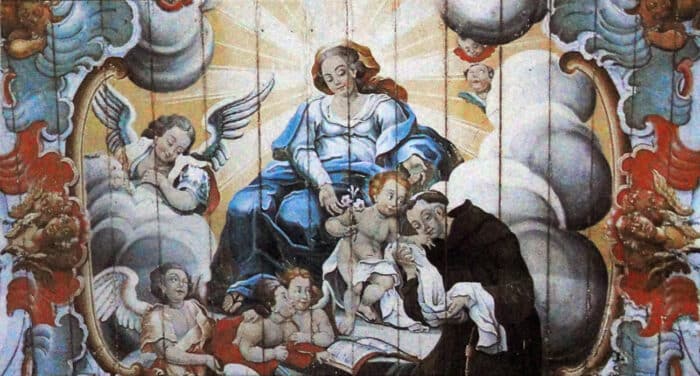
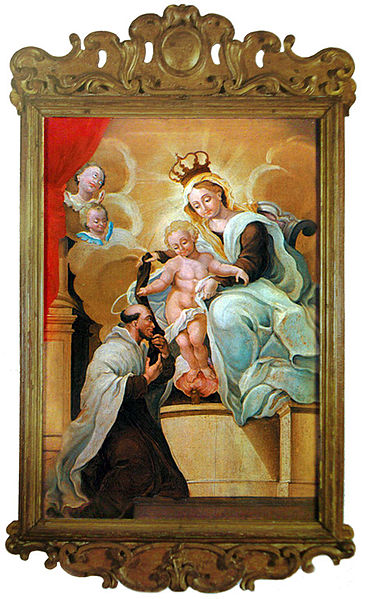

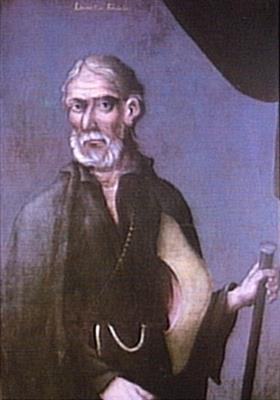
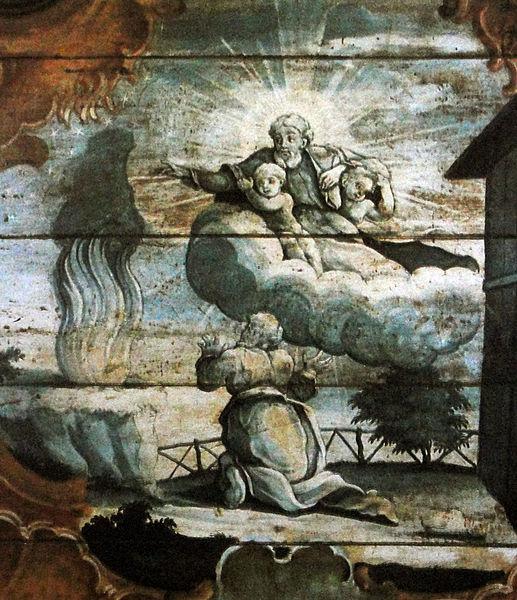

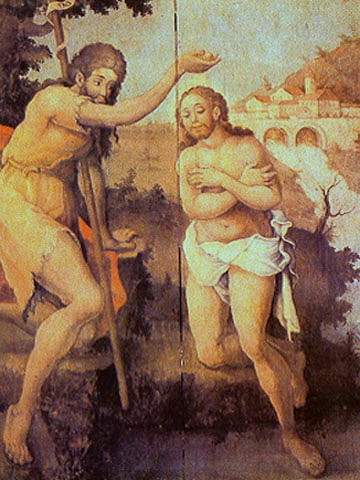
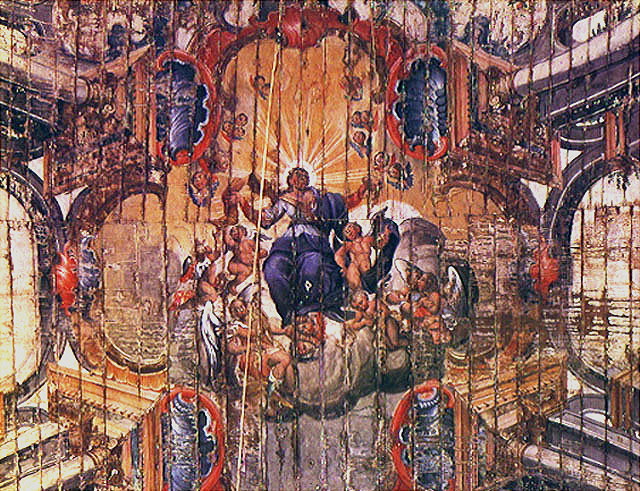

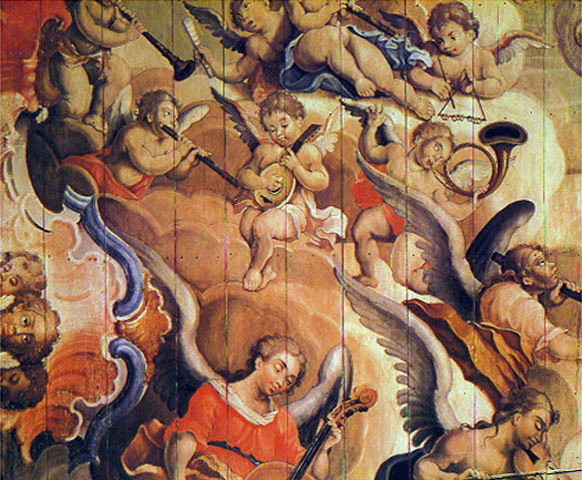

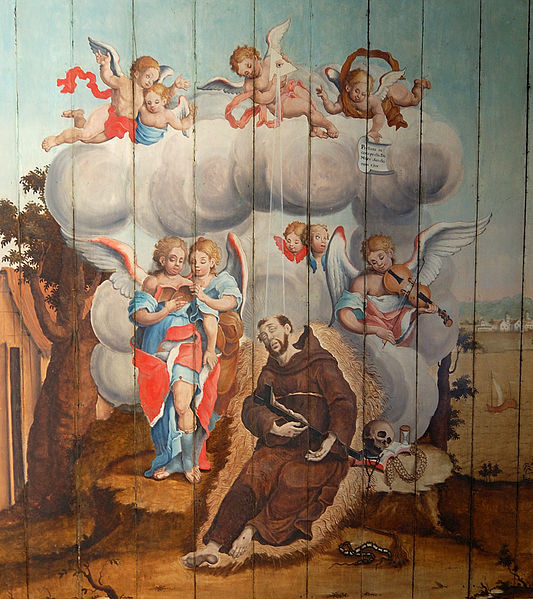
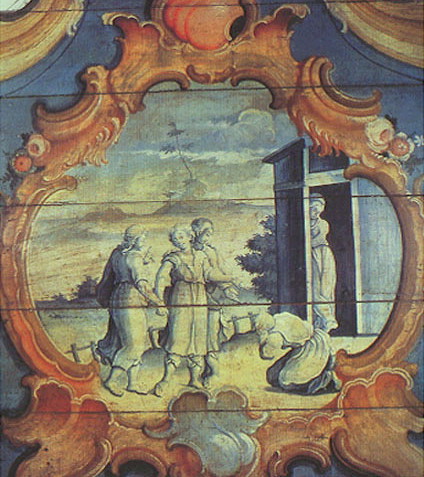
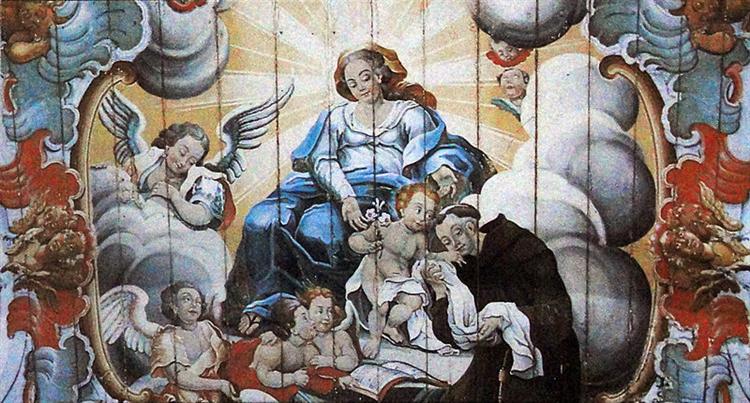
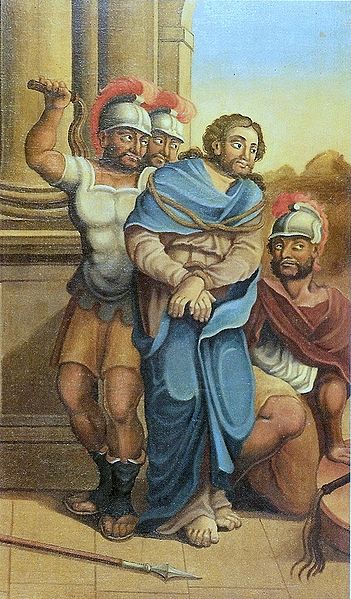
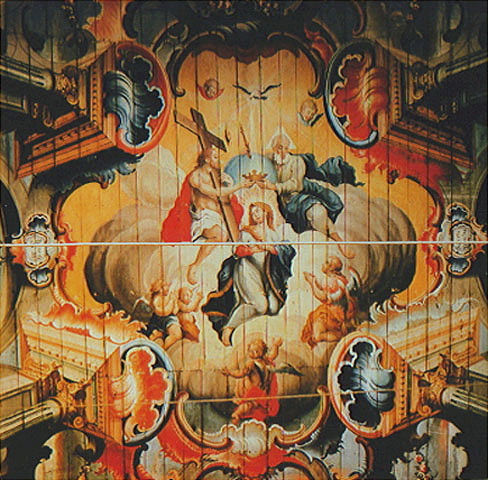
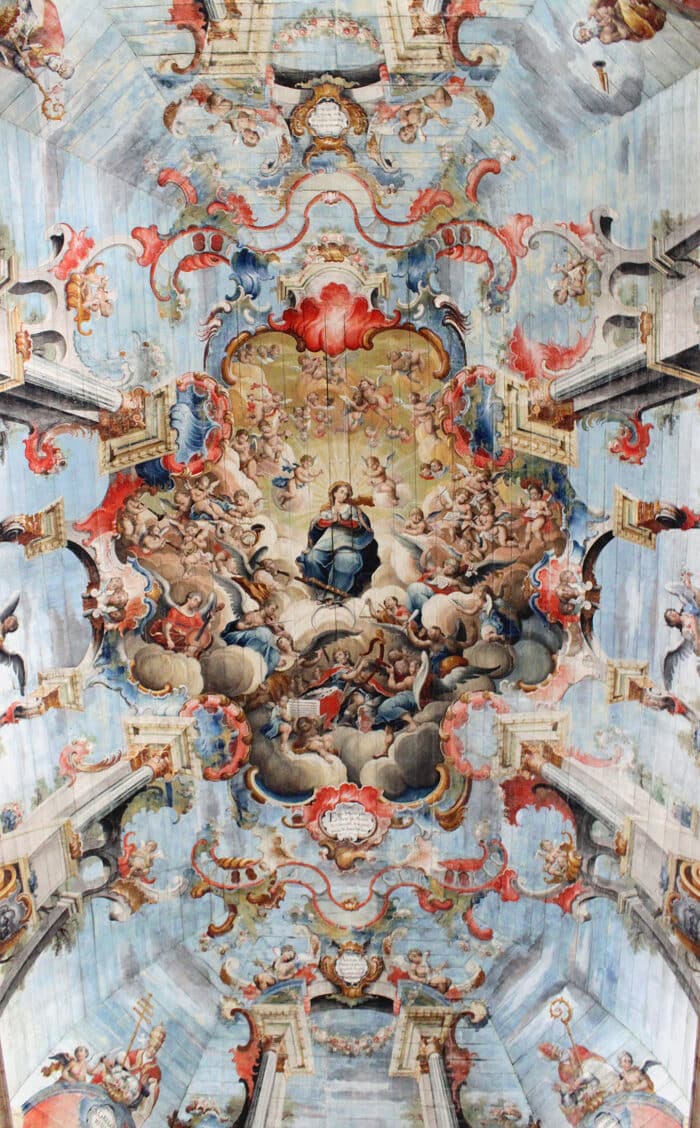
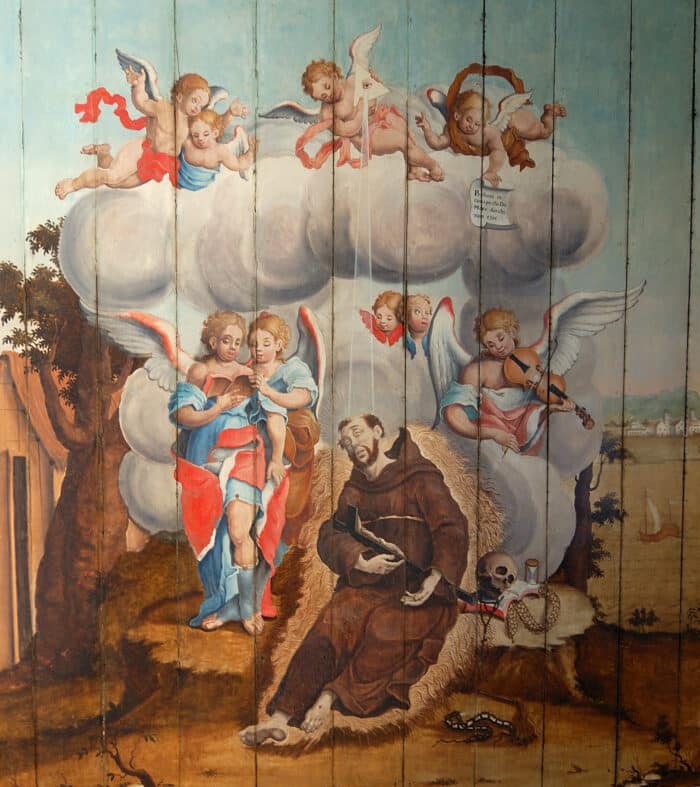
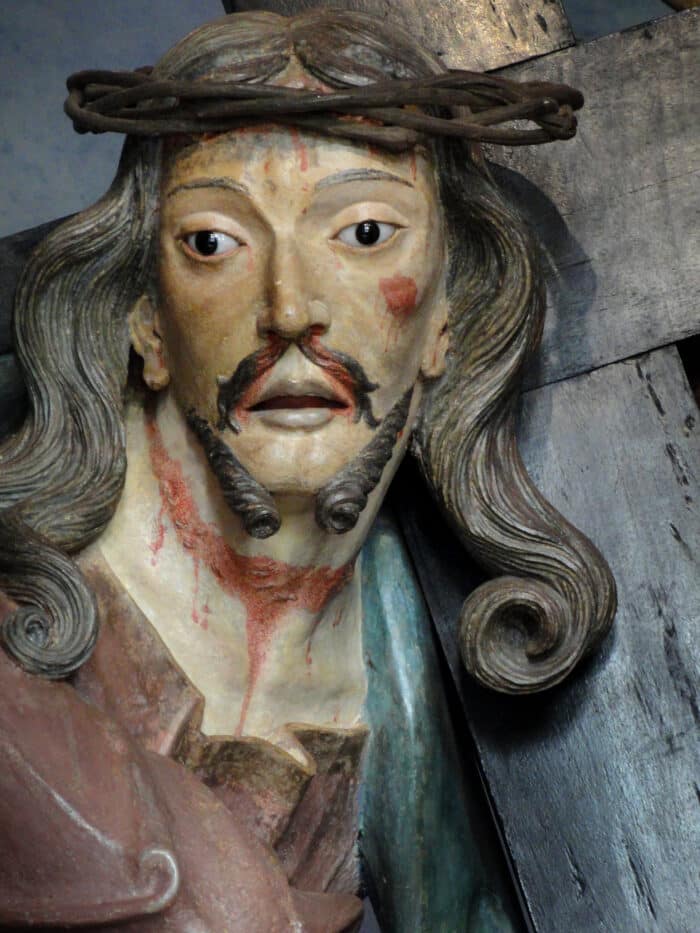





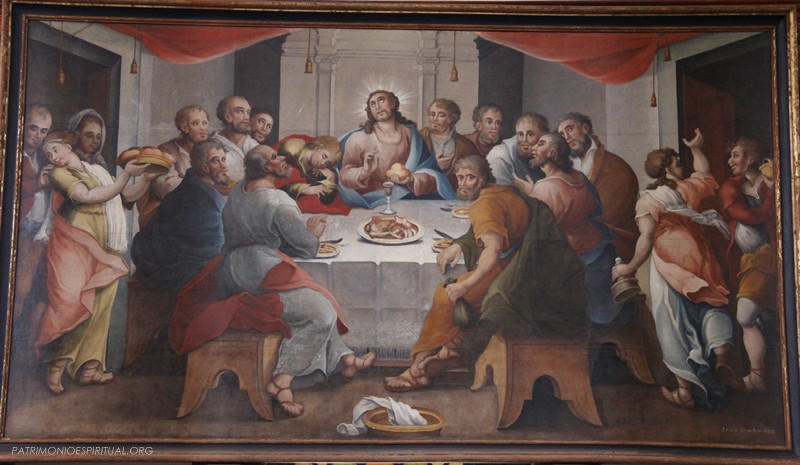
“The Last Supper by Mestre Ataíde: a masterpiece from the Caraça collection
The painting The Last Supper, painted in 1828 by the lieutenant painter Manuel da Costa Ataíde (1762-1830), is one of the most important artistic expressions in the Caraça Complex, both for its symbolic richness and its formal composition.
In the centre of the canvas, the figure of Christ stands out, illuminated by an intense light, an element that enhances his divine nature. He is surrounded by the twelve apostles, harmoniously arranged in groups of three according to the classical canons of sacred composition.
The table, covered with a lace tablecloth, carefully depicted with visible folds, evokes authenticity and realism. On it are the bread and wine, Eucharistic symbols par excellence, as well as a plate of lamb, a clear allusion to the Paschal lamb, which refers to Christ’s redemptive sacrifice.
At the lower level, the basin and towel used in the washing of the feet suggest the dimension of Christian love as service, anticipating the Passion narrative.
The figure of Judas Iscariot, the betrayer, stands at the front of the table, about to leave the room. He holds a bag of money, the symbol of his betrayal, and his expression seems to be directed at the spectators, establishing a direct dialogue with those contemplating the work, regardless of their position in the church – a typical feature of Baroque theatricality.
At the far end of the scene, on the left, three figures form a secondary episode: a young maid carrying loaves of bread is caressed by a man who follows her closely, while a mulatto woman, a constant presence in Ataíde’s work, reinforces his attention to Afro-descendant identities in the colonial context. On the right, two more figures enter the scene in a celebratory and spontaneous manner, extending the narrative beyond the apostolic centre.
According to the Casa’s records, the painting cost 350,000 réis and was commissioned by Father Jerônimo de Macedo, then superior of Caraça. The authorial attribution, now confirmed, was later confirmed by the German painter George Grimm, who, on visiting the site, inscribed Ataíde’s name on the work, as the artist rarely signed his works.
This painting synthesises the genius of Mestre Ataíde in combining the symbolic rigour of Catholicism, the technical delicacy and the inclusion of different social types, resulting in a work that transcends the mere religious record and asserts itself as a historical, theological and aesthetic document.
4.3. Woodcarving, Gilding and Statue Painting
Detail of “Christ Carrying the Cross”, part of a series of sculptures by Aleijadinho, represented by Mestre Ataíde.

As well as painting ceilings, canvases and wood panelling, Mestre Ataíde made gilded wood carvings and painted statues using a technique known as incarnation and upholstery.
Incarnation aims to imitate the effect of human flesh on the visible parts of the body (such as the face and hands), while upholstery imitates clothes and fabrics. His works can be found in several churches in Minas Gerais.

He also left his mark on various aspects of church decoration, designing the architecture of altarpieces and liturgical objects such as candlesticks and crucifixes.
An example of his work is the Church of the Third Order of Our Lady of Mount Carmel in Ouro Preto. It shows how Ataíde saw interior decoration: as a single work, integrating architecture, painting, carving and objects.
In addition, he was an illustrator (painting illustrations in Brotherhood Commitment Books) and painted the most important series of Statues of Aleijadinho, installed in the Chapels of the Steps of the Sanctuary of Bom Jesus de Matosinhos.
Publicações Relacionadas
Tourist attractions and routes in Serra do Cipó MG
Church of St Francis of Assisi - Ouro Preto: History, architecture and art
Aleijadinho: Biography and works that shaped the Brazilian Baroque
Little Church of Pampulha MG: history, architecture and religious importance
Sanctuary of Bom Jesus de Matozinhos - History and Architecture
Diamantina - Tourist Attractions, History and Architecture
History and Monuments of Tiradentes MG
Catas Altas MG - History and Monuments
Ouro Preto: Historic City of Tourist and Cultural Interest
Mariana: A journey through time to colonial Brazil
Pico do Itacolomi - Attractions, history and itineraries
Tourist Attractions and History of the Caraça Sanctuary MG
Royal Road Route - History, routes and attractions
Sabará: A Journey Through Its Rich History
Summary of the history of Minas Gerais
São João del Rei MG - Attractions, History and Architecture
Tourist Attractions and History of Serro in Minas Gerais
This post is also on:
![]() Português
Português ![]() English
English ![]() Deutsch
Deutsch ![]() Español
Español ![]() Français
Français
